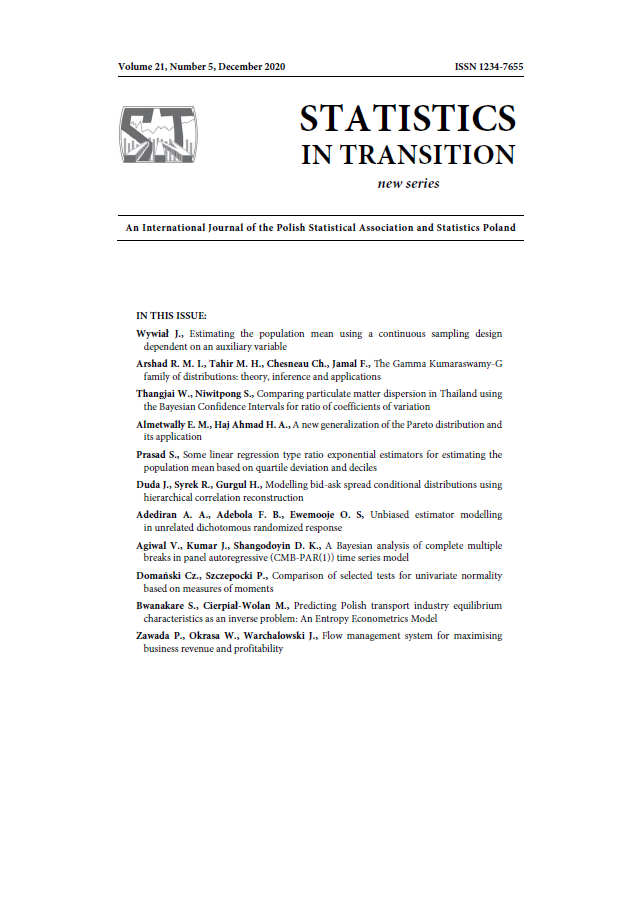ARTICLE
ABSTRACT
Continuous distribution of variables under study and auxiliary variables are considered. The purpose of the paper is to estimate the mean of the variable under study using a sampling design which is dependent on the observation of a continuous auxiliary variable in the whole population. Auxiliary variable values observed in this population allow to estimate the inclusion density function of the sampling design. The variance of the continuous version of the Horvitz-Thompson estimator under the proposed sampling design is compared with the variance of the mean of a simple random sample. The accuracy of the estimation strategies is analysed by means of simulation experiments.
KEYWORDS
continuous sampling design, Horvits-Thompson estimator, inclusion density, sampling scheme, bivariate gamma distribution, ratio estimator
REFERENCES
BĄK, T., (2014). Triangular method of spatial sampling. Statistics in Transition, Vol. 15, No. 1, pp. 9–22. http://stat.gov.pl/en/sit-en/issues-and-articles-sit.
BĄK, T., (2018). An extension of Horvitz-Thompson estimator used in adaptive cluster sampling to continuous universe. Communications in Statistics – Theory and Methods, vol. 46, Issue 19, pp. 9777–9786, DOI: 10.1080/03610926.2016.1218028.
BENHENNI, K., CAMBANIS, S., (1992). Sampling Designs for Estimating Integrals of Stochastic Processes. The Annals of Statistics, Vol. 20, No. 1, pp. 161–194.
BUCKLEW, J. A., (2004). Introduction to Rare Event Simulation. Springer, New York, Berlin, Heidelberg, Hong Kong, London, Milan, Paris, Tokyo.
CORDY, C. B., (1993). An extension of the Horvitz-Thompson theorem to point sampling from a continuous universe. Statistics and Probability Letters, Vol. 18, pp. 353–362.
COX, D. R., SNELL, E. J., (1979). On sampling and the estimation of rare errors. Biometrika, Vol. 66, 1, pp. 125–32.
CHERIYAN, K. C., (1941). A bivariate correlated gamma-type distribution function. Journal of the Indian Mathematical Society, Vol. 5, pp. 133–144.
CRESSIE, N. A. C., (1993). Statistics for Spatial Data. Wiley, New York.
FROST, P. A., TAMURA, H., (1986). Accuracy of auxiliary information interval estimation in statistical auditing. Journal of Accounting Research 24, pp. 57–75.
GHIRTIS G. C., (1967). Some problems of statistical inference relating to double-gamma distribution. Trabajos de Estatistica, Vol. 18, pp. 67–87.
HORVITZ, D. G., THOMPSON, D. J., (1952). A generalization of the sampling without replacement from finite universe. Journal of the American Statistical Association, Vol. 47, pp. 663–685.
KOTZ, S., BALAKRISHNAN, JOHNSON, N. L., (2000). Continuous Multivariate Distributions, Vol. 1: Models and Applications. John Wiley & Sons, Inc., New York, Chichester, Wenheim, Brisbane, Sigapore, Toronto.
MCKAY, A. T., (1934). Sampling from batches. Journal of the Royal Statistical Society 2, pp. 207–216.
RIPLEY, B. D., (1987). Stochastic Simulation. Wiley, 1987, New York. Sarndal S¨arndal C. E., Swenson B., Wretman J. (1992). Model Assisted Survey Sampling. Springer Verlag, New York-Berlin-Heidelberg-London-Paris-Tokyo-Hong Kong-Barcelona-Budapest.
TILL ´ E, Y., (2006). Sampling Algorithms. Springer.
THOMPSON, M. E., (1997). Theory of Sample Survey. Chapman & Hall, London, Weinheim, New York, Tokyo, Melbourne, Madras.
WILHELM M., TILL ´ E, Y., QUALIT´ E, M., (2017). Quasi-systematic sampling from a continuous population. Computational Statistics & Data Analysis, 105, pp. 11–23.
WILKS, S. S., (1962). Mathematical Statistics. John Wiley & Sons, New York, London.
WYWIAŁ, J. L., (2016). Contributions to Testing Statistical Hypotheses in Auditing. PWN, Warsaw.
WYWIAŁ, J. L., (2018). Application of two gamma distribution mixture to financial auditing. Sankhya B, Vol. 80, issue 1, pp. 1–18.
ZUBRZYCKI, S., (1958). Remarks on random, stratified and systematic sampling in a plane. Colloquium Mathematicum, Vol. 6, pp. 251–262. DOI: 10.4064/cm-6-1-251-264, http://matwbn.icm.edu.pl/ksiazki/cm/cm6/cm6135.pdf.
